#if the illustration is from 1611
Note

everything reminds me of him

#A hound.#answered#specialneedz#Vasco#irl Vaschete sightings#if the illustration is from 1611#that's within Vasco's lifetime#period accurate golden boy
1K notes
·
View notes
Text
Maggie’s pendants and good omens
Yes, you’ve read it right. This post is going to deal with some literal good omens, not just title drop! But first things first, let’s take a closer look at the topic of this analysis.


A toucan
The top necklace is a lovely design involving a crowned toucan — believed to be a messenger of gods able to travel between the spiritual and the physical world, often associated with rain and rainbow (a Christian symbol of divine love, grace, and mercy, a reminder of the covenant between God and humanity to spare the latter from future trials like the Flood) — encircled by a gold band (a symbol of infinity, eternal love and promise) spun by a small butterfly (a symbol of transformation, hope, and rebirth). All three symbols combined seem to deliver a divine message of hope for rebirth, possibly resurrection, and the eternal life. Very fitting in the context of the Second Coming.
The fact that toucans were revered by the native South Americans as rainbringers strengthens the symbolic meaning of another type of bird we can spot on Maggie’s clothes in the very first episode, as her character introduction — a swallow. Swallows flying low are also believed to be harbingers of rain and bad weather. If you see one close to Earth or a building, it means that there’s a storm — or a certain biblical tempest — on the horizon.
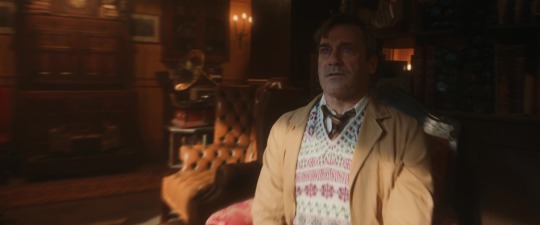
In Ancient Greece and Rome swallows were representing Aphrodite, goddess of love. In Christianity they were considered to be of God and symbolized hope, awakening, and revival of life as messengers of spring and protectors from winter colds. Also helped Jesus on the Cross — according to a Christian legend, a group of swallows was supposed to take out the thorns from the Crown of Thorns and alleviate His Passion on the Cross. Humans banding together in the name of good have been a big theme in the series ever since The Them made an appearance, and from what we already know about the unpublished Good Omens sequel, we can assume that Jesus is going to take the spotlight in the upcoming season.
Maggie definitely attracts sudden inexplicable weather changes, like a thunderstorm with weirdly localized lightning strikes or a sudden downpour. And we’re still waiting for some vavooming (and the following happy ending) to happen in S3.

A heart with an eye
Now, the more nuanced clue hidden in the bottom necklace. I know that some of us were trying to tackle the concept of Maggie’s eye in a heart pendant suggesting her Masonic connotations, but this symbol (or the Eye of Providence in general) isn’t strictly Masonic, it isn’t even limited only to Judeo-Christian art. And while it is used a lot in Christian iconography, we should focus on a very specific example of it already referenced in the show.
Buckle up, we’re making a parachute dive into S1.
It seems like our old friend, Agnes Nutter, still has our backs.

Prophecy 4020:
Let the wheel of fate turne, let harts enjoin, there are othere fyres than mine; when the whirl wynd whirls, reach oute one to another.
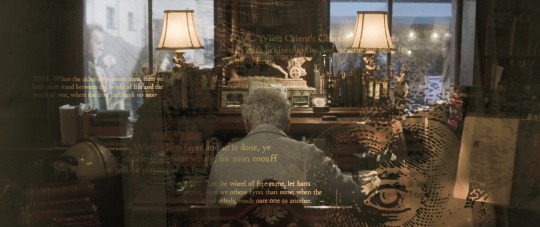
If you look closely at the bottom right corner of this frame, you will see that as an illustration for the above prophecy the production team chose a 1611 engraving titled The Minde should have a fixed Eye On Objects, that are plac’d on High first found in Gabriel Rollenhagen’s Nucleus emblematum selectissimorum.
In 1635 it was published in A Collection of Emblemes, Ancient and Moderne Quickened With Metrical Illustrations, both Morall and Divine, Etc by George Wither with the accompanying hymn:

A Heart, which bore the figure of an Eye
Wide open to the Sunne; by some, was us'd,
When in an Emblem, they would signifie
A Minde, which on Celestiall Matters mus'd:
Implying, by the same, that there is nought
Which in this lower Orbe, our Eyes can see,
So fit an Object for a manly thought,
As those things, which in Heav'n above us be.
God, gave Mankinde (above all other Creatures)
A lovely Forme, and upward-looking Eye,
(Among the rest of his peculiar Features)
That he might lift his Countenance on high:
And (having view'd the Beauty, which appeares
Within the outward Sights circumference)
That he might elevate above the Sphæres,
The piercing Eye, of his Intelligence.
Then, higher, and still higher strive to raise
His Contemplations Eyes, till they ascend
To gaine a glimpse of those eternall Rayes,
To which all undepraved Spirits tend.
For, 'tis the proper nature of the Minde
(Till fleshly Thoughts corrupt it) to despise
Those Lusts whereto the Body stands inclin'd;
And labour alwayes, upward to arise.
Some, therefore, thought those Goblins which appeare
To haunt old Graves and Tombes, are Soules of such,
Who to these loathsome places doomed were,
Because, they doted on the Flesh too much.
But, sure we are, well-minded Men shall goe
To live above, when others bide below.
And hey, guess what 4020, i.e., the number of the prophecy, symbolizes in Strong’s Concordance? Periergazomai, a Greek word meaning “to waste one's labor about something” — to meddle, going beyond proper boundaries (where a person doesn't belong); to fixate on what others are doing, instead of doing what the person himself is supposed to do.
It appears only once in the Bible:
2 Thessalonians 3:11: We hear that some among you are idle and disruptive. They are not busy; they are busybodies. Such people we command and urge in the Lord Jesus Christ to settle down and earn the food they eat. And as for you, brothers and sisters, never tire of doing what is good.
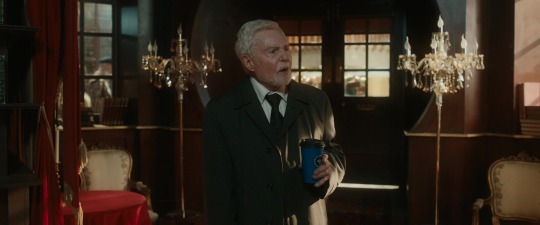
To make things slightly more interesting, in the Hebrew version of Strong’s Concordance 4020 has another meaning — migbaloth, meaning “twisted things, i.e. cords”. Which doesn’t make much sense until we read the actual passage:
Exodus 28:24 and two chains of pure gold, twisted like cords; and you shall attach the corded chains to the settings.
And compare it to the most recent post on the topic published directly by Word of God:

What if all these clues didn’t apply to Maggie and Nina, but Aziraphale and Crowley instead? What if Maggie served as a messenger — consciously or not — just like the toucan, delivering the prophecy to those who need it most?
“When the tempest comes and darkness and great storms, and the dead will leave their graves and walk the Earth once more and there will be great lamentations for the end is near, don’t lose hope, hold hands and look up.”

Basically what Aziraphale and Crowley already did when they performed the 25 Lazarii miracle, only with no interference from Gabriel this time around.
And, if both Strong’s Concordance and Maggie’s personal addition to her second pendant are to be believed, with a wedding band somehow involved in the process.
#everything has a meaning#the invisible and unbreakable line that joins Crowley and Aziraphale#two chains of pure gold twisted like cords#never tire of doing what is good#don’t lose hope#hold hands and look up#the good omens crew is unhinged#good omens props#good omens costumes#the nice and accurate prophecies of agnes nutter#agnes nutter#good omens#maggie service#good omens meta#good omens analysis#strong’s concordance#yuri is doing her thing#ineffable husbands#wedding bands
75 notes
·
View notes
Text
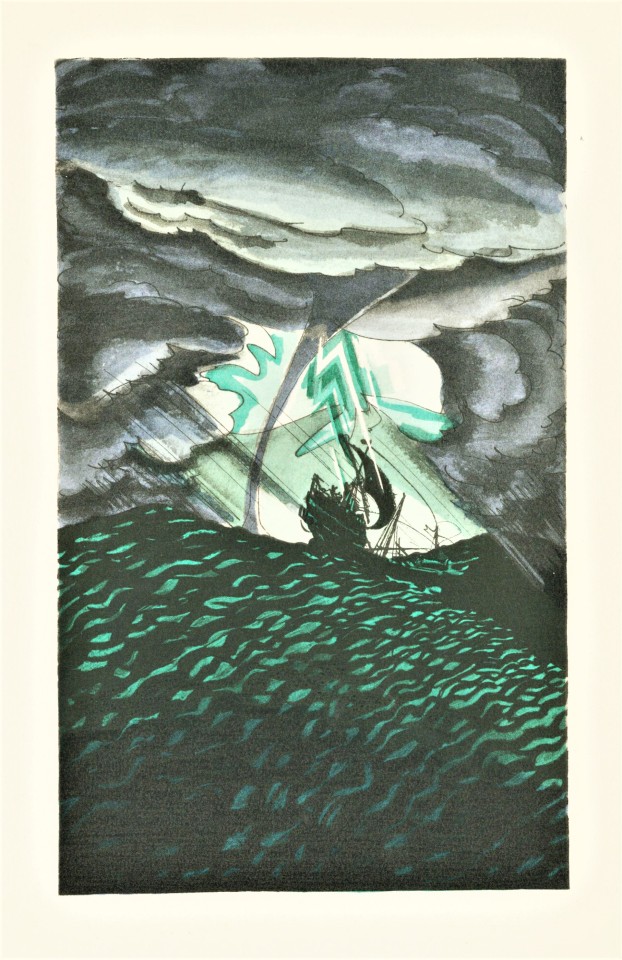




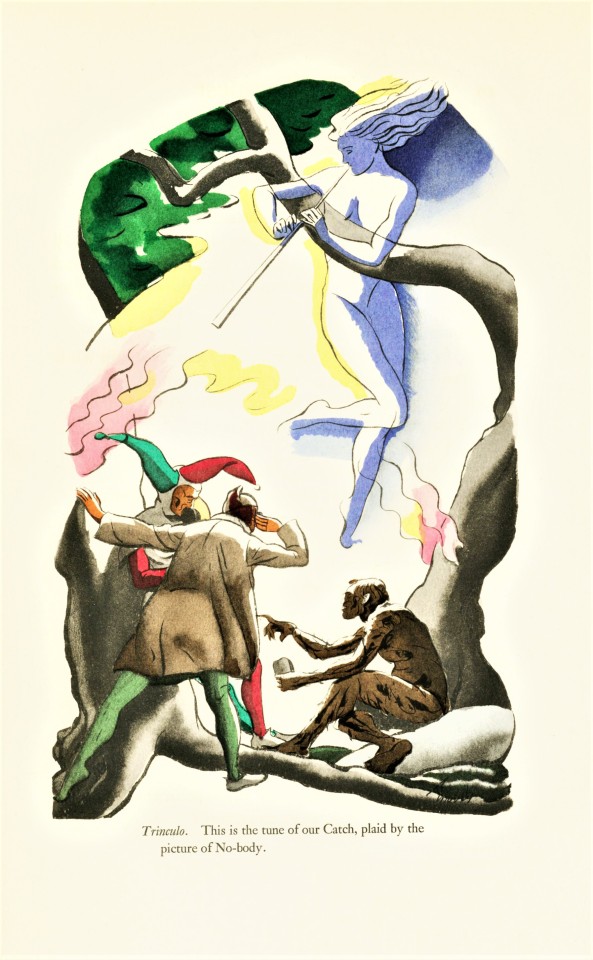


Shakespeare Weekend
This weekend we pore over Shakespeare’s romantic drama, The Tempest, the thirty-first volume of the thirty-seven volume The Comedies Histories & Tragedies of William Shakespeare, published by the Limited Editions Club (LEC) from 1939-1940. The Tempest was written between 1610-1611 and is thought to be one of Shakespeare’s latest completed works. It was first printed in 1623 as part of the First Folio and is further recognized as the first play within the publication. Historians note that The Tempest was the most well printed of the Folio and typeset by three compositors known as B, C, and F.
Edward A. Wilson (1886-1970) illustrated the LEC’s publication of The Tempest. Born in Scotland, Wilson emigrated with his family to America at the age of seven and settled in Chicago. He attended the Art Institute of Chicago, studied under renowned illustrator Howard Pyle, and became an acclaimed book and advertising illustration artist in his own right. Wilson’s illustrations for The Tempest were reproduced from watercolors, in a three-part process that achieved vivacious results. When asked about his approach to illustrating the play, Wilson wrote that he composed the images and characters “so that, all together, they would carry the spirit of fantasy and unreality which Shakespeare intended.”
The volume was printed in an edition of 1950 copies at the Press of A. Colish. Each of the LEC volumes of Shakespeare’s works are illustrated by a different artist, but the unifying factor is that all volumes were designed by famed book and type designer Bruce Rogers and edited by the British theatre professional and Shakespeare specialist Herbert Farjeon. Our copy is number 1113, the number for long-standing LEC member Austin Fredric Lutter of Waukesha, Wisconsin.

View more Limited Edition Club posts.
View more Shakespeare Weekend posts.
-Jenna, Special Collections Graduate Intern
#shakespeare weekend#william shakespeare#shakespeare#the tempest#edward a. wilson#bruce rogers#limited editions club#lec#herbert farjeon#first folio#watercolor illustrations
34 notes
·
View notes
Text
Wilde is not a Social Class
part 1: What "Civil" and "Wilde" really meant
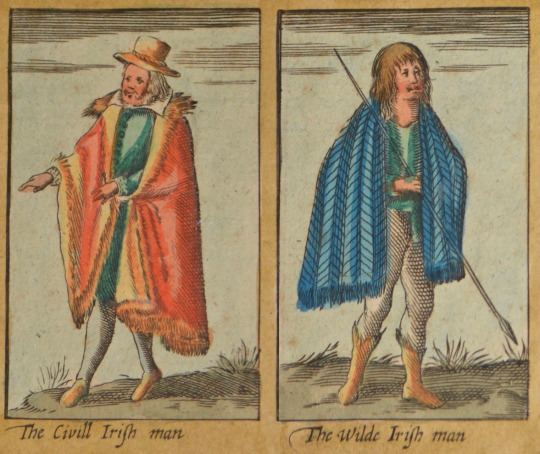
The "Civill" Irish man and the "Wilde" Irish man from a 1676 colorization of John Speed's 1611 map of Ireland
“the wilde men in Ireland, properly called Woodkarne . . .”
-John Derrick “The Image of Irelande” 1581
The labels ‘civil’ and ‘wilde’ show up in several 16th and 17th century depictions of Irish people. These include an illustration by Lucas De Heere, John Speed's map of Ireland, and John Derrick's The Image of Irelande, which are all frequently used as sources in Irish dress history. Many modern viewers have misinterpreted these terms as indicators of socioeconomic status or social class with 'civil' interpreted as meaning middle class and 'wilde' interpreted as poor. (Dunlevy also specifies that 'civill Irish' means the '(non-military) middle class'. The word civilian did not acquire the meaning 'not part of the military' until the 19th century, so it is not applicable to 16th and 17th c. usage.) This misconception about the historical meaning of these terms distorts our understanding of how the Irish dressed during the 16th and 17th centuries. In order to accurately interpret these images, we first need to understand how the terms 'wilde' and 'civil' were actually used during this period.
In this post, I will discuss what these terms meant historically, how they were used in 16th and 17th c descriptions of the Irish, and what they are actually telling us about the Irish people in Speed's illustrations.
The terms 'wilde' and 'civil' were used not by the Irish themselves but instead by the British and continental Europeans to describe the Irish (Dunlevy 1989). John Speed and John Derrick were English; Lucas De Heere was a Flemish artist who never went to Ireland and was given information about the Irish by the English (McClintock 1943).
Randle Cotgrave's A Dictionarie of the French and English Tongues, published in 1611, gives us a period definition of civil. It defines Civil as: "civill, courteous, gentle, mannerlie, well-behaved; also, temperate, mild, quiet; also, towne-bred, or burguerlike; also, politicke, lay, secular, civill." There is nothing about wealth or social class in this definition. Civil instead means civilized; it refers to a person's behavior or urban residence.
The concept of the wild man as the antithesis of urban-dwelling, civilized man is as old as civilization itself, with the oldest recorded example being the ancient Sumerian figure of Enkidu from the stories of Gilgamesh. It shows up in ancient Greek and Roman texts as monstrous wild men being said to live in foreign places like Libya and Ethiopia. In Christian Medieval Europe, wild men became a hairy subhuman race separate from, yet living near, civilization (Husband 1980).
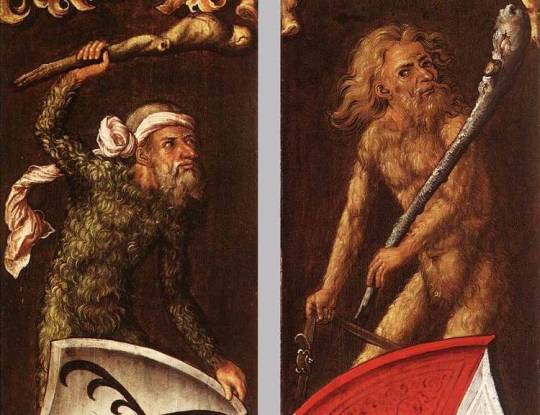
2 Wild Men by Albrecht Dürer, 1499
Medieval wild men and women had long, unkempt hair, wore little to no clothing, and fed on wild plants and raw meat rather than farming. They were characterized as violent, brutish and irrational. Because of their proximity to nature, they were sometimes portrayed as having an unusually close relationship with animals, able to ride horses without a saddle or bridle (Husband 1980).

Wild man riding with no bridle and sticks for a saddle c1480 by Ludwig Schongauer
Although the hairy wild man of the late Middle Ages was a mythical being, this barbaric, uncivilized archetype clearly influenced 16th and 17th c portrayals of the Irish.
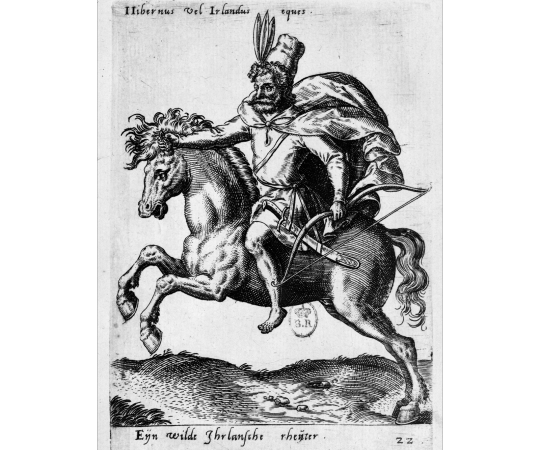
Abraham De Bruyn's c1578 "wild" Irish rider rides bareback and bridleless, in spite of the fact that the 16th c. Irish used saddles and bridles. John Speed writing in 1611 implies the complete Irish diet was watercress, roots, mushrooms, shamrocks, butter with oatmeal, milk, whey, raw meat, and congealed blood with butter. This list fits nicely with a wild man's no-farming lifestyle and conveniently omits the bread, roast mutton, meat pie, and alcohol mentioned in other period accounts of Ireland (ex Gernon 1620, Vital 1518).
These conceptions of 'wild' and 'civil' played an influential part in British colonialist policies in Scotland and Ireland. The 16th c English and King James the VI and I considered the Gaelic Irish and Highland Scots to be barbaric and the English and Lowland Scots to be civil. The plantations of Ulster and the Isle of Lewis were created as part of a series of attempts by the British crown to 'civilize' these areas (i.e. eradicate Gaelic culture). In a 1607 letter about the plantation of Lewis, King James I called the settlers "civile gentlemen" and the native Scots "wilde weedes" (Brochard 2019).
Earlier attempts by the British to "civilize" Ireland involved banning Irish culture. A 1537 statue of Parliament stated that people in Ireland were savage and wild, because of . . . cultural diversity. Yes, really.
"There is [. . .] nothing which doth more conteyne and keep many of [the King's] subjects of this his said land, in a certaine savage and wilde kind and maner of living, then the diversitie that is betwixt them in tongue, language, order, and habite, which by the eye deceiveth the multitude, and perswadeth unto them, that they should be as it were of sundry sorts, or rather of sundry countries, where indeed they be wholly together one bodie . . ."
-An Act for the English Order, Habite, and Language, Rolls of Parliament cap. 26, 28th year of Henry VIII (1537). (cited in Butler 1786). (emphasis added)
King Henry VIII was apparently afraid that the "savage" manner of living practiced by the Irish (i.e. speaking Irish, following Brehon law, and wearing Irish clothing, instead of using English language, customs, and clothing) would persuade the rest of Europe that the British Isles were not, in fact, one happily united kingdom. Of course, instead of just letting England and Ireland to be sundry countries, his solution was to ban Irish language and clothing. This policy was continued by later 16th c. British colonial administrators in Ireland.
"The inhabitants of the cities and corporate towns shall wear no mantles, shorts [sic] Irish coats, or great shirts, nor “suffer their hair to grow glebb, but to wear clerks’ gowns, jackets, jerkins, and some civil garments;” and no maid or single woman shall “wear or put on any great roll or kercher of linen cloth upon their heads, neither any great smock with great sleeves, but to put on hats, caps, French hoods, tippets, or some other civil attire upon their heads;”
-1571 Laws and ordinances proclaimed at Limerick by Sir John Perrot, Lord President of Munster [. . .] to be observed throughout that province (cited in Carew 1867). (emphasis added)
The permitted "civil" garments: gowns, jackets, jerkins, hats, caps, French hoods, and tippets were items worn in England during the 16th c. (Mikhaila & Malcolm-Davies 2006) while the banned garments: bratanna, ionair, léinte, linen rolls, and kerchiefs, and the hairstyle, glibs, are Irish fashions (Dunlevy 1989, McClintock 1943).
These examples make it clear that to 16th and 17th c artists like John Speed 'civil' meant English and 'wilde' meant Gaelic Irish. The "Civill Irish man" was anglicized. He spoke English, wore English clothing styles, and followed British laws. The "Wilde Irish man" remained culturally Gaelic. He spoke Irish, wore Irish clothing, and followed Brehon law. 'Civil' and 'wilde' did not indicate level of wealth; they indicated level of acculturation.
In part 2 of this post, I will discuss how well the interpretation that the 'wilde' Irish were poor and the 'civil' Irish were middle class matches what we actually know about dress in 17th c Ireland. Was acculturation level actually correlated with wealth?
Acknowledgement: I would like to thank the members of the reenactment group Wilde Irish for making me aware of this subject.
Bibliography:
Brochard, Thomas (2019). Plantation: Its Process in Relation to Scotland’s Atlantic Communities, 1590s–1630s. Journal of the North Atlantic, Special Volume 12, 73-94. https://www.jstor.org/stable/27133161
Butler, James G. (Ed.) (1786). The Statutes at Large, Passed in the Parliaments held in Ireland (Vol. 1). George Grierson, London.
Carew, George (1867). Calendar of the Carew Manuscripts, 1515-1574 Preserved in the Archiepiscopal Library at Lambeth. (J.S. Brewer, & W. Bullen, Eds.). Longsman, Green, Reader, & Dyer, London.
Cotgrave, Randle (1611). A Dictionarie of the French and English Tongues. Adam Islip, London.
Dunlevy, Mairead (1989). Dress in Ireland. B. T. Batsford LTD, London.
Gernon, Luke (1620). A Discourse of Ireland.
Husband, Timothy, & Gilmore-House, Gloria (1980). The Wild Man: Medieval Myth and Symbolism. The Metropolitan Museum of Art, New York.
McClintock, H. F. (1943). Old Irish and Highland Dress. Dundalgan Press, Dundalk.
Mikhaila, Ninya, & Malcolm-Davies, Jane (2006). The Tudor Tailor. Quite Specific Media Group, Ltd, London.
Speed, John (1611). The Theatre of the Empire of Great Britaine: presenting an exact geography of the kingdomes of England, Scotland, Ireland, and the iles adioyning. William Hall, London.
Vital, Laurent (1518). Archduke Ferdinand's visit to Kinsale in Ireland, an extract from Le Premier Voyage de Charles-Quint en Espagne, de 1517 à 1518. translated by Dorothy Convery.
#decolonizing history#irish history#irish dress#gaelic ireland#stair na héireann#16th century#17th century#art#british colonialism#dress history#historical dress#statutes and laws
14 notes
·
View notes
Text
The Three Ravens
There were three rauens sat on a tree,
downe a downe, hay downe, hay downe
There were three rauens sat on a tree,
with a downe,
There were three rauens sat on a tree,
They were as blacke as they might be.
With a downe, derrie, derrie, derrie, downe, downe.

Art by rubyblossom
The one of them said to his mate,
Where shall we our breakfast take?
Downe in yonder greene field,
There lies a Knight slain under his shield,
His hounds they lie downe at his feete,
So well they can their Master keepe,
His Hawkes they flie so eagerly,
There's no fowle dare him come nie

Art: "The Three Ravens" by Edward Frederick Brewtnall
Downe there comes a fallow Doe,
As great with yong as she might goe,
She lift up his bloudy head,
And kist his wounds that were so red,
She got him up upon her backe,
And carried him to earthen lake,
She buried him before the prime,
She was dead her self ere euen-song time.
God send euery gentleman,
Such haukes, such hounds, and such a Leman.

Illustration by G. Howell-Baker (1901)
A rather well-known English folk-ballad, dating back to at least the 16th century and compiled by Thomas Ravenscroft – who else? – in 1611. Alas, the three poor corvids are deprived of their meal, since the slain knight’s pregnant paramour, the leman, buries his remains before the ravens can dine. And dies. And it is open for debate if the authors of the gloomy piece actually wish “death” to every gentleman or just someone to mourn them properly when they are gathered unto their ancestors.
And here is a rather charming rendition of the song by "The Black Country Three" from 1966
youtube
24 notes
·
View notes
Text
Ariel:
"On a bat's back I do fly."
From Shakespeare's "The Tempest," 1611. Illustration by Louis Rhead, 1918.
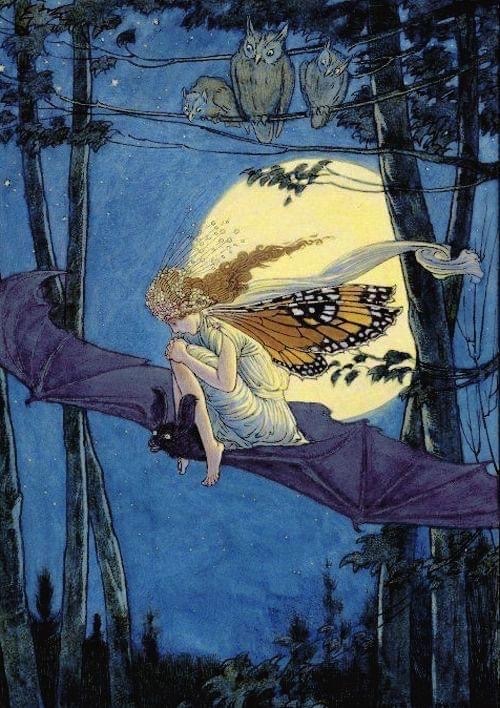
#shakespeare#the tempest#On a bat's back I do fly.#Ariel#illustration#art#the tempest 1611#Louis Rhead#1918#imagika#owls#bat#fly
20 notes
·
View notes
Text
Life as a Senior NCO for a Head of Household that can't Provide.
So, all of this works. Until it gets into real estate claims. Which effects my labor costs.
My taxable services are supposed to assume additional costs, without just compensation, as a gesture of goodwill and charity?
I have to offer 1342 & 1611, as a guide to a lost economy that will not obey the laws regarding Minimum Wage. Substantially increasing the demand for skilled labor, from the burden of clawbacks.
But this is further compounded by the U.S. Government's acknowledgement of Military Requirements to defend the U.S., where the U.S. Government is then too reliant on Private Assemblies?
Biblical texts somehow bind my officers with Ancient Italia. And the history of a common financial bond instrument.
The sale of such, lavished lifestyles, fundamentally conflicts with the life long prison sentence for the mere survival of birthright.
As if the money that has been secured was anything other than a victim of arrogance. And the denial of common civil rights affecting our dinner tables.
Sergeant Major Nathan, Marksmith North Wales Militia/ Joint Militia Detachment Brigade (Virginia Militia Association)







_______________________________________
Acts of Heroism, from the Brotherhood within our Community.


_______________________________________
Random illustrations of ancient arrow craftsmanship:
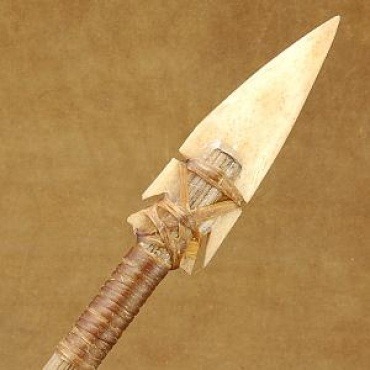

I like to think our commonality with Taiwan has the essence of Chinese Silk, and "Jade."
There's only one way to get that high.
0 notes
Text

Benedetto Manasseri (1526 - April 4, 1589) an Italian of African descent, was born near Messina, Italy to Cristoforo and Diana Manasseri in 1526. His parents, captured as enslaved from Africa in the early 16th century, were brought to San Fratello, near Messina. They converted to Catholicism and, due to their loyalty to the Church, obtained his freedom at birth. He did not attend school because his family was impoverished. He worked as a shepherd in his youth, he would give any extra money he could to the poor. He was befriended by a nobleman, Jerome Lanze, who encouraged the youth to join a society of hermits under the teachings of St. Francis of Assisi. He became one of Lanze’s principal advisors and, succeeded Lanze as superior of the Franciscan-affiliated group of hermits.
During the third Council of Trent in 1564, Pope Pius IV decided to disband the hermit societies, whereupon he encouraged their communities to join the Franciscan orders. He became a member of the Order of Friars Minor he was sent to Palermo, to the Franciscan Friary of St. Mary of Jesus. He rose through the Order, first starting as a cook and advancing to Master of Novices and to Guardian of the Community. As a lay brother, he continued drawing people to hear his teachings of the Scriptures and to experience his professed healing abilities. He returned to the kitchens because he enjoyed cooking. Having suffered persecution throughout his life due to being “il Moro,” or dark-skinned, he is remembered for his racial tolerance.
He became the patron of Palermo. In 1611 King Phillip III of Spain added a shrine for him, at which time his body was again exhumed and to be placed in the shrine. In 1743 he was beatified by Pope Benedict XIV, and in 1807 he was canonized by Pope Pius VII. He came to illustrate the inhumanity of the slave trade. His feast day is celebrated on April 4th.
Since Benedict has become the patron saint of Black Catholics in America, several churches are bearing his name in DC, Savannah and Columbus, Georgia, New York City, St. Augustine, Florida, Pittsburgh, Omaha, Winston-Salem, Milwaukee, and Chicago. #africanhistory365 #africanexcellence
1 note
·
View note
Text

The map given to me displays the title "Shakespeare's Britain" in the top right corner. The land mass depicted is England, Scotland, and Wales. Ireland also appears just before the edge of the map on the left side. This material is a researched map based on other representations of the landscape with a blend of literature with reality. The map was published in 1964 by The National Geographic Society for the magazine in the "Geographic Art Department" and is based on another map from 1611. Research for the map is credited to John D. Garst.
The overall style lends itself to mythological and storybook aesthetics. The use of type is historical, calligraphic, and reminiscent of printing methods and the design of printed material of the 1600s. The map is thematic, displaying a blend of history, literature, fantasy, and mythology, presenting a perspective on England's landscape during Shakespeare's works. It aims to tell a story in the past tense as a presentational map showcasing the relationship between the work of Shakespeare and actual historical figures, dates, and events that he wrote about, indicating its purpose as an educational or illustrative resource.
It showcases the relationship between Shakespearean literature and real historical contexts, possibly for academic or storytelling purposes. A banner even suggests this idea of presentation as it is written, "Performed by Lisa Biganzoli, N.G.S. staff." Including real and fictional names suggests a linguistic focus, highlighting the interplay between historical figures, Shakespearean characters, and those behind producing the material. This linguistic aspect is crucial in bridging the map's gap between reality and fiction.
Combined with Western mythology, the map parallels Shakespearean themes and broader Western cultural narratives. This might represent how Shakespeare's works contribute to or reflect upon Western mythology, cultural identity, and storytelling.
"Shakespeare's Britain" is not only a map but a narrative journey through time and imagination. Through its calligraphic style and mythological aesthetics, the map educates and captivates in its storytelling inherent in cartography and literature.
0 notes
Text
The Sun is Lost
Looking at the celestial globes of the Venetian Coronelli (1650–1718) it is possible to appreciate the cosmos, as it was before modern science swept it away. My guide to star maps comments “The constellation figures are detailed, robust, and theatrical, in keeping with their Baroque style.”
The emphasis is on pictorial splendour, although the locations of stars are accurate. One of Coronelli’s clients was Louis XIV, the Sun King, and there is a strong feeling, for me, of the ancien regime about to be swept away by a deluge of abstraction and rationality. As early as 1611, John Donne had written
And new philosophy calls all in doubt,
The element of fire is quite put out,
The sun is lost, and th'earth,
and no man's wit Can well direct him where to look for it.
The world, as an orderly place made up of proximate living objects, was replaced by chaos, distance and coldness. A star map plays a particular trick of showing empty immensities overlaid with familiar corporeal things. The trick is called cosmography, and the scientific revolution of the seventeeth century brought it to an end. Alexandre Koyré summed it up as two events: “the destruction of the cosmos” and “the geometrization of space”:
As for myself, I have endeavored in my Galilean Studies to define the structural patterns of the old and the new world-views and to determine the changes brought forth by the revolution of the seventeenth century. They seemed to me to be reducible to two fundamental and closely connected actions that I characterised as the destruction of the cosmos and the geometrization of space, that is the substitution for the conception of the world as a finite and well-ordered whole, in which the spatial structure embodied a hierarchy of perfection and value, that of an indefinite or even infinite universe no longer united by natural subordination, but unified only by the identity of its ultimate and basic components and laws; and the replacement of the Aristotelian conception of space—a differentiated set of innerworldly places—by that of Euclidean geometry—an essentially infinite and homogenous extension—from now on considered as identical with the real space of the world.
The spiritual change that I describe did not occur, of course, in a sudden mutation. Revolutions, too, need time for their accomplishment; revolutions, too, have a history. Thus the heavenly spheres that encompassed the world and held it together did not disappear at once in a mighty explosion; the world-bubble grew and swelled before bursting and merging with the space that surrounded it.
From about 1800 onward, the illustrative constellation figures on star maps were progressively deleted. It happened over the course of the career of the mathematician and astronomer Gauss. Around 1800, he calculated the orbit of the asteroid Ceres, and a symbol was assigned to it–the sickle. By the time he died in 1855, asteroids were no longer being given symbols, but were numbered instead. Over the same period, star atlases evolved from the lavishly illustrated Uranographia of 1801 to the completely plain maps of the 1840s. The rectilinear boundaries of the constellations, defined in terms of celestial coordinates, were the only lines left on the charts. In science more generally, a Cartesian grid of rationalization had been laid over nature, facilitating abstraction and numerical measurement.
It is easy, in isolation, to mourn this move from the figurative and fanciful to the inhumanly precise and austere presentation of data. Many other changes took place in this period which cannot be boiled down to a simple transition from the poetic to the prosaic. But there is something compelling about about the loss of the powerfully visual, detailed constellation illustrations, and their replacement with mere geometry, a reductive set of measured points.
The fact is that when an astronomer goes into his observatory for his night's work he finds it usually convenient to leave all the ecstatic and most of the poetic portions of his constitution outside.—Robert Ball (1892)
1 note
·
View note
Text
Tips for Buying Facsimiles of Rare Bible Books
Buying a rare and antique Bible book needs you to have deep pockets. You should also have adequate knowledge to distinguish between a fake copy and the original, or else, you could be taken for a ride by unscrupulous elements. However, not everyone may have the money to buy the original copy of a rare Bible book. In such cases, looking for high-quality facsimiles that reproduce the original content without any changes or deletions is worth considering.
In today’s technology-driven age, many people have moved from physical books to electronic devices for most of their reading. But the scenario is different for rare book collectors and even those who buy facsimiles of the original rare Bible books. For these people, the excitement of holding a piece of literary history remains unparalleled. As a result, there’s a high demand for rare and antique bibles and their replicas.
According to some credible sources, the Bible is the world’s best-selling book of all time, having sold almost 5 billion copies to date. Naturally, rare Bible books and their facsimiles find many takers. From the Gutenberg Bible and 1378 Wycliffe New Testament to 1535 Coverdale Bible, 1536 Tyndale New Testament, 1560 Geneva Bible, and more, there’s a lot to choose from when buying facsimiles of rare Bible books. But you need to shop carefully.
Given below are some steps to help you make the most of your investment when buying antique Bibles and their replicas. .
Do Your Homework Regarding What Edition is the Most Valuable
There’s a difference between a Bible being rare and one being a collectible. You can consider “rare” a measure of how easy or difficult it is to get hold of the Bible. But what makes a Bible collectible is a different matter. From who worked on it to its illustrator, binding, where it was printed, or its special features (like notes in the margin, woodcut illustrations, etc.) - everything can make it a collectible. Even the previous owner, especially if the person was a celebrity or someone famous, could make the Bible a collector’s item.
Many people also believe that first editions of a Bible are more valuable. But that isn’t always true. Sometimes, later editions with inadvertent mistakes or additional information or illustrations can be sold at five to ten times (or even more) the price of the first edition. And depending on how valuable the original Bible book is, the demand will rise or fall for its facsimile.
Keep an Eye on the Amount You Pay
The cost of a facsimile usually varies with the original Bible’s value. From the condition of its pages and binding to the special features it has (say, woodcut illustrations), every factor will influence its value. Apart from a Bible book’s physical condition, its content also significantly contributes to its desirability.
Experts handling rare books say that the most valuable pieces are those that altered the course of history or human understanding. Thus, the price of the original Gutenberg Bible (1455) and its facsimile will be a lot more than the English Hexapla (1841) and its facsimile reproduction.
Know the Features to Look For
What features make a Bible book and its replica valuable is something you should know. For instance, when buying a facsimile reproduction of the 1611 King James Bible, you should look for Gothic-style typeface and Jacobean-style spelling.
If buying a facsimile reproduction of the Gutenberg Bible, taking a closer look at its Gothic typeface is a must. It should have a medieval look and be slightly less pointed and compressed than other examples that came to the forefront shortly thereafter.
If buying a facsimile reproduction of the Gutenberg Bible, taking a closer look at its Gothic typeface is a must. It should have a medieval look and be slightly less pointed and compressed than other examples that came to the forefront shortly thereafter.
Why Trust Reliable Dealers of Bible Books
Not every buyer may have the knowledge or an eye to spot the minute differences between the original and its replica. Some may not even know about the features thoroughly, making identifying them an uphill task. That’s why it pays to buy your Bible book replicas from a reliable and reputed dealer of such books to ensure you get your money’s worth.
Wrapping Up
Instead of blindly buying a replica of an original Bible that’s old and rare, you should know the things mentioned above to make an informed buy and avoid being duped. So, go ahead and get your facsimile reproduction of a Bible book that you have been eyeing for quite some time now.
Original Source:
http://rare-bibles.com/tips-for-buying-facsimiles-of-rare-bible-books.html
0 notes
Text
[PDF] Download KJV, Personal Size Reference Bible, Sovereign Collection, Leathersoft, Brown, Red Letter, Comfort Print: Holy Bible, King James Version -- Thomas Nelson Publishers
Download Or Read PDF KJV, Personal Size Reference Bible, Sovereign Collection, Leathersoft, Brown, Red Letter, Comfort Print: Holy Bible, King James Version - Thomas Nelson Publishers Free Full Pages Online With Audiobook.

[*] Download PDF Visit Here => https://best.kindledeals.club/0785239235
[*] Read PDF Visit Here => https://best.kindledeals.club/0785239235
This beautiful Bible edition honors the legacy of the King James Version Bible in a convenient portable size with essential study tools and traditional red-letter text for the Words of Christ.The Sovereign Collection continues Thomas Nelson's long history and stewardship publishing Bibles. King James Sovereign Collection editions draw from the legacy of the trustworthy and timeless KJV with elegant drop cap illustrations leading into each chapter, the exclusive Comfort Print typeface inspired by centuries-old Thomas Nelson editions, and more classic Bible details.In 1611, the King James Version Bible, also known as the Authorized Version, was published. Nearly 50 of the day’s finest scholars, all from the Church of England, had been organized into six groups for the task. Using the Bishop’s Bible of 1568 as the basis for this revision, the Old Testament was translated from Hebrew and the New Testament from Greek. The completed work was then peer-reviewed before being sent to bishops
0 notes
Text
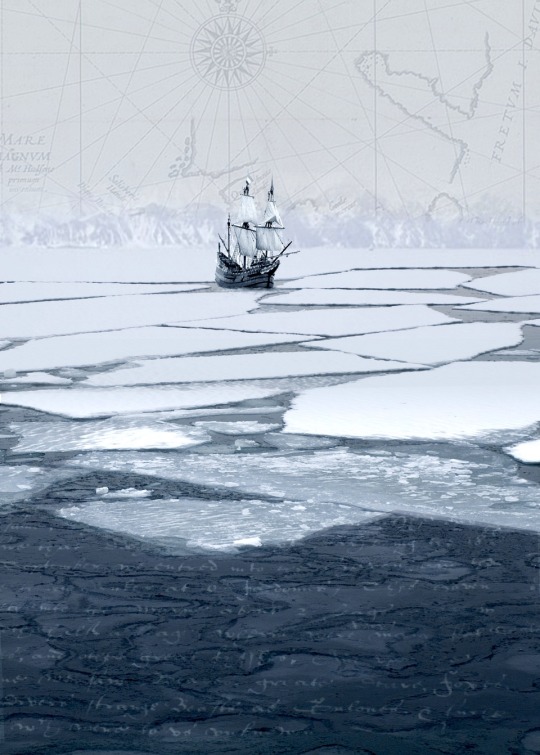
The Hudson Mutiny 1611 in : God’s Mercies: Rivalry, Betrayal, and the Dream of Discovery, written and illustrated by Douglas Hunter, 2007
During a voyage to Hudson Bay begun in 1610 to find the legendary Northwest Passage, disputes arose among the crew of the Discovery, the ship Henry Hudson used on his third expedition.
A mutiny ensued, due to scurvy, little food and another winter in the ice, Hudson, his son and seven others were abandoned in a small boat in June 1611. The castaways were never heard from again, and nothing definitive is known about what happened to them.
Only eight of the mutineers survived the depriving voyage back to Ireland. There they were tried for the mutiny but not convicted. A court found that abandoning experienced sailors in an open boat near islands that appeared to be inhabited was not murder. It is likely that the Admiralty was more interested in the seamen's information than in their conviction.
105 notes
·
View notes
Text
Shakespeare Weekend!
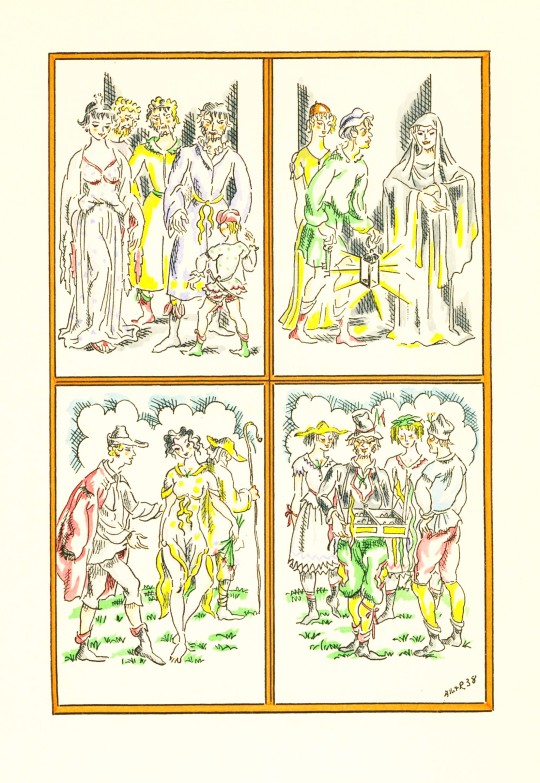




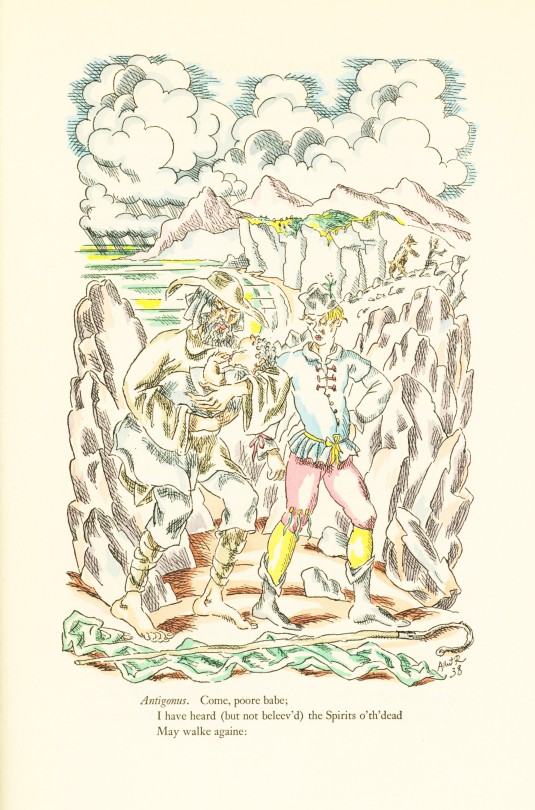
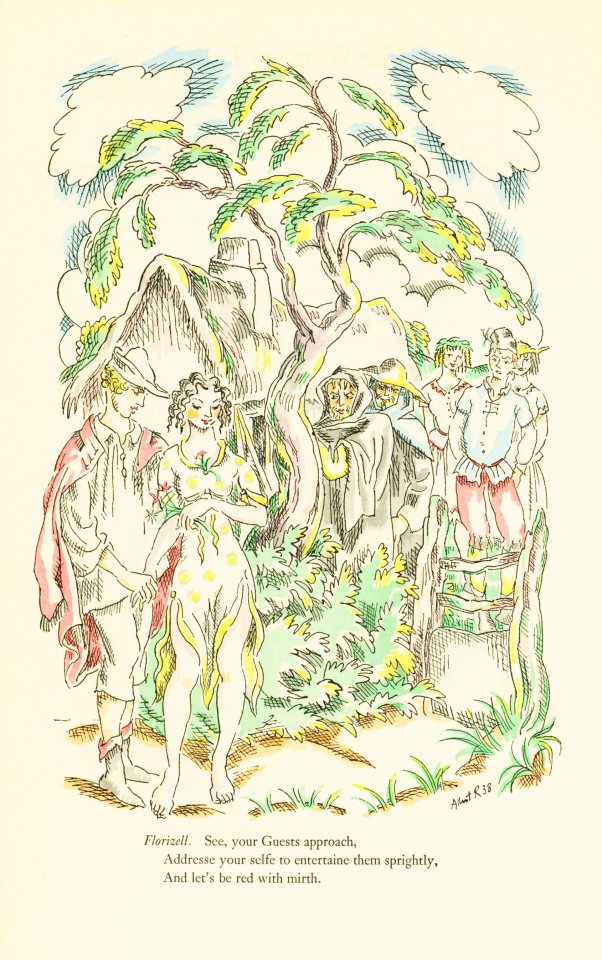

It is time to say adieu to our Limited Editions Club adventure as we present the last volume, Shakespeare’s dramatic comedy, The Winter's Tale, the thirty-seventh volume of the thirty-seven volume The Comedies Histories & Tragedies of William Shakespeare, published by the Limited Editions Club (LEC) from 1939-1940. We will have, however, plenty of other material from our Shakespeare collection to present in the coming weeks. The Winter’s Tale was written and performed in 1611 but was not published until its inclusion in the First Folio of 1623. The play was heavily influenced by Robert Greene’s prose Pandosto: A Triumph of Time, although Shakespeare made several plot changes, most notably saving the life of Hermione.
British artist Albert Rutherston’s (1881-1953) water-color drawings illustrate The Winter’s Tale with colorfully simple narratives based on his set design for the Granville-Barker production of The Winter’s Tale in 1912. Rutherston studied art at the Slade School of Fine Art in London and experienced widespread fame upon completion with paintings on display at the British Museum, Tate Gallery, and the Victoria and Albert Museum. He has illustrated dozens of children’s books, designed stage decorations for ballets, and created posters for the London Underground. It is said his work does not stir the soul but soothes the eye as can be seen in the pleasant watercolors published here. The black outlines of the drawings were printed from line plates with actual watercolor applied through stencils at the atelier of Jean Saudé in Paris.
The volume was printed in an edition of 1950 copies at the Press of A. Colish. Each of the LEC volumes of Shakespeare’s works are illustrated by a different artist, but the unifying factor is that all volumes were designed by famed book and type designer Bruce Rogers and edited by the British theatre professional and Shakespeare specialist Herbert Farjeon. Our copy is number 1113, the number for long-standing LEC member Austin Fredric Lutter of Waukesha, Wisconsin.

View more Limited Edition Club posts.
View more Shakespeare Weekend posts and stay tuned as we dig into our collection for more Shakespeare materials!
-Jenna, Special Collections Graduate Intern
#shakespeare weekend#shakespeare#william shakespeare#a winter's tale#albert rutherston#Jean Saudé#watercolor#pochoir#illustrations#limited editions club#lec#press of a. colish#bruce rogers#herbert farjeon#Jenna
22 notes
·
View notes
Photo

Vampires, witches and other demonic creatures in the Ottoman period —Illustration from an edition of the Book of Travels by Evliya Çelebi (1611–1682), an Ottoman explorer who travelled through the territory of the Empire and neighboring lands over a period of forty years • via Bibliothèque Infernale on FB
43 notes
·
View notes
Text

Prospero: "Graves at my command have waked their sleepers!"
- From Shakespeare's "The Tempest," 1611. Act V, Scene I. Illustrated by Edmund Dulac, watercolor, 1908.
5 notes
·
View notes